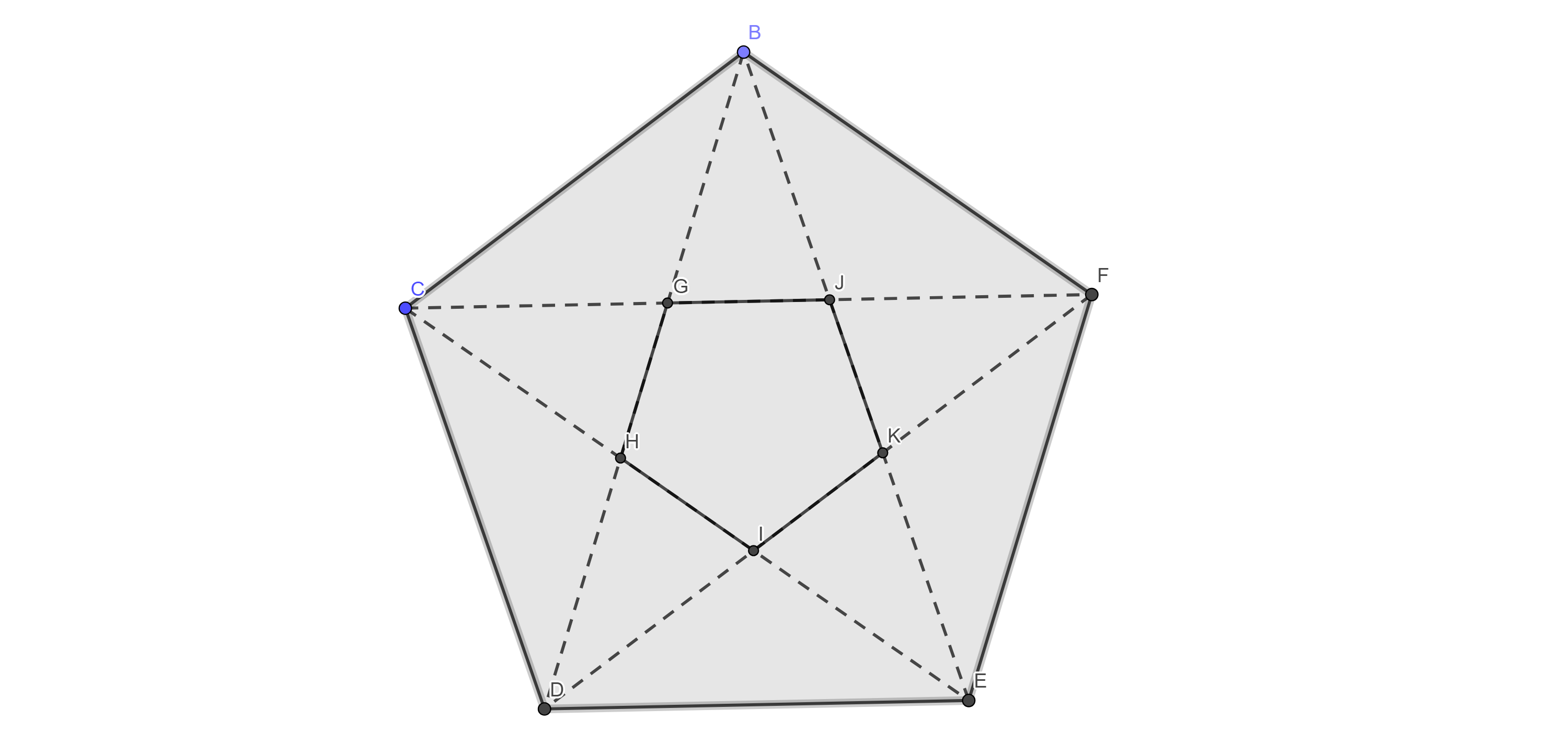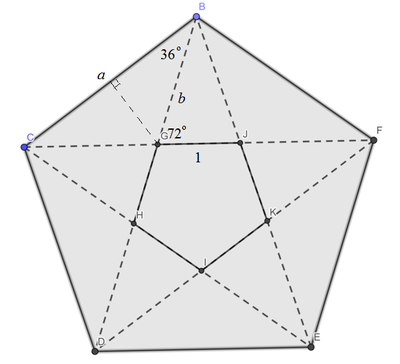The Gold Pentagon

The area of the small regular pentagon is A . The area of the big regular pentagon is B . What is B A ?
The answer is 0.145898034.
This section requires Javascript.
You are seeing this because something didn't load right. We suggest you, (a) try
refreshing the page, (b) enabling javascript if it is disabled on your browser and,
finally, (c)
loading the
non-javascript version of this page
. We're sorry about the hassle.
2 solutions

Let the side length of the small regular pentagon G J = 1 , the side length of the big regular pentagon B C = a , and the length \(BG=b). Since area of similar shape is directly proportional to the square of linear dimension, we have:
\(\begin{align} \frac AB & = \frac 1{a^2} & \small \color{blue} \text{Note that }a = 2b \cos 36^\circ \\ & = \frac 1{(2b\cos 36^\circ)^2} & \small \color{blue} \text{and }b = \frac {\frac 12}{\cos 72^\circ} \\ & = \frac {\cos^2 72^\circ}{\cos^2 36^\circ} \\ & = \left(\frac {2\cos^2 36^\circ - 1}{\cos 36^\circ}\right)^2 \\ & = \left(2\cos 36^\circ - \frac 1{\cos 36^\circ}\right)^2 & \small \color{blue} \text{also } \cos 36^\circ = \frac {1+\sqrt 5}4 \text{ (see note)} \\ & = \left(\frac {1+\sqrt 5}2 - \frac 4{1+\sqrt 5}\right)^2 \\ & = \left(\frac {\sqrt 5-1}{\sqrt 5+1}\right)^2 = \left(\frac {3-\sqrt 5}2 \right)^2 \\ & = \frac {7-3\sqrt 5}2 \approx \boxed{0.146} \end{align} \)
Note: Note that cos 3 6 ∘ = cos 5 π and
cos 5 π + cos 5 3 π cos 5 π − cos 5 2 π cos 5 π − 2 cos 2 5 π + 1 4 cos 2 5 π − 2 cos 5 π − 1 ⟹ cos 5 π = 2 1 = 2 1 = 2 1 = 0 = 4 1 + 5
Too bad, I computed B/A, but it was correct!
The interior angle of a regular pentagon is 1 0 8 ° , and by symmetry B G = B J = J F . Since a straight line is 1 8 0 ° , ∠ B G J = ∠ B J G = 1 8 0 ° − 1 0 8 ° = 7 2 ° , and by vertical angles ∠ B J F = 1 0 8 ° . Since the angle sum of a triangle is 1 8 0 ° , ∠ G B J = 3 6 ° , and since △ B J F is an isosceles triangle, ∠ J B F = ∠ J F B = 2 1 8 0 ° − 1 0 8 ° = 3 6 ° .
Let x be the side of the small regular pentagon, and let 1 be the side of the big regular pentagon, so that G J = x and B F = 1 . Since ∠ F B G = ∠ F G B , △ F B G is an isosceles triangle and B F = G F = 1 . That means J F = G F − G J = 1 − x , and B G = B J = J F = 1 − x
Since △ F G B ∼ △ B G J by AA similarity, 1 − x 1 = x 1 − x , and this solves to x = 2 3 − 5 for x < 1 . The ratio of the sides of the small pentagon to the big pentagon is 1 x = 2 3 − 5 , and the ratio of the areas is the square of this, which is x 2 = ( 2 3 − 5 ) 2 = 2 7 − 3 5 ≈ 0 . 1 4 5 8 9 8 0 3 4 .
(Incidentally, this ratio is also ϕ 4 1 , where ϕ = 2 1 + 5 , the golden ratio.)